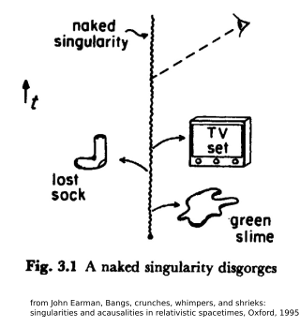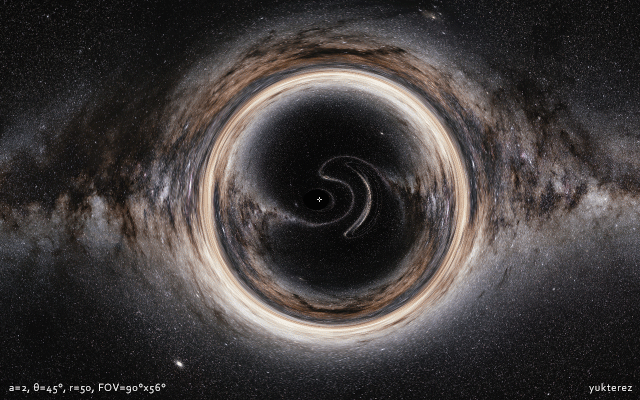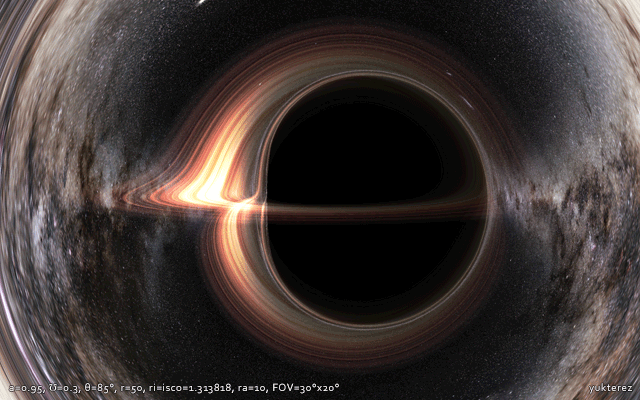We know that the theory of cosmic censorship prevent singularities from existing without an event horizon that hides them from the Universe. Now let's assume that this theory is somehow false, and a naked singularity appears in the solar system. How would we notice it for the first time, what would it look like, how would it behave and could we use it for someting useful?
-
$\begingroup$ Related: Rotating black holes and naked singularity $\endgroup$– m0nhawkCommented Jul 18, 2015 at 8:22
-
6$\begingroup$ A naked singularity would behave unpredictably, which is after all the whole point! $\endgroup$– John RennieCommented Jul 18, 2015 at 10:39
3 Answers
We know that the theory of cosmic censorship prevent singularities from existing without an event horizon that hides them from the Universe.
We don't really know whether cosmic censorship is true or false. It isn't even clear how to state it rigorously as a hypothesis. For some info on the current state of CC, see this question. There are serious suggestions that gravitational collapse may in some cases result in the formation of a naked singularity.
Now let's assume that this theory is somehow false, and a naked singularity appears in the solar system. How would we notice it for the first time, what would it look like, how would it behave and could we use it for someting useful?
A naked singularity's very definition makes it impossible for GR to say how it would look or predict how it would behave. A singularity is by definition a situation you get when geodesics are incomplete. So for example, if a ray of light hits a singularity, by definition we can't use GR to trace the ray through the singularity and see where it goes when it emerges. More generally, naked singularities can in general emit arbitrary information and unlimited energy (in GR). That means that we can't use GR to predict what comes out of them (without even worrying about tracing rays through them). This is shown by John Earman's memorable figure and caption below:
The worry is illustrated in Fig. 3.1 where all sorts of nasty things -- TV sets showing Nixon's 'Checkers' speech, green slime, Japanese horror movie monsters, etc. -- emerge helter-skelter from the singularity.
The reason that GR can't predict what comes out of the naked singularity is simply that we can't even formulate the initial conditions in an appropriate way, because a Cauchy surface doesn't exist. For more on this, see this question.
If a naked (timelike) singularity did exist, then GR might be able to tell us about light rays that passed near it but not too close. That is, we might be able to construct a partial Cauchy surface, which might be good enough to tell us, for example, what distortions we would see in the background of stars. We would probably expect the large-distance behavior of such a spacetime to be characterizable just by its mass and angular momentum (assuming it doesn't have weird properties like the kind of topological behavior you get in things like Taub-NUT spacetimes), in which case the part of the sky far enough away from the singularity would probably look approximately like what you would get with a Kerr black hole. I would not expect to be able to extend this to regions very close to the singularity, where you would have closed, timelike curves, and therefore wouldn't even be able to formulate initial conditions for an optical simulation.
what would it look like?
Assuming no accretion disk, the gravity lensing of an overextremal Kerr singularity with a/M=2 in front of the Milky Way background would look like this when you view it from the equatorial plane (the left side of the singularity is rotating toward the observer):
At 45° you see a dark spot where the geodesics lead into the negative space behind the ring:
And even more so when you view it from above (counterclockwise rotation):
For comparison the same background image from ESO/Brunier without distortion:
Another example of a spinning and charged naked singularity with an accretion disk:
For comparison a black hole with similar, but subextremal properties:
The dark spot in the 2nd and 3rd image might also be bright, depending on whether the negative space behind the ring is empty or a universe of its own.
how would it behave?
Assuming the ring's diameter is large enough, if Alice and Bob would fall through the ring from opposite sides simultaneously, they also should emerge simultaneously on the other side of the two sheeted space:
At least that's the relativistic solution, though nature might prevent such naked rings due to the cosmic censorship theorem. Nevertheless, for more details and an analytic solution of the silhouettes in the upper images see Maeda, page 14 (Phys. Rev. D80, 024042, 09) and DeVries, page 20 (DOI:10.1088/0264-9381/17/1/309).
-
$\begingroup$ Your final link is broken. When fixing it, please note that links to papers should point to (i) landing pages (not pdfs), (ii) stable links that are robust against link rot (i.e. the DOI if it is at all available), and (iii) to legal resources. If users then want to go to piracy sites to look for their paper, that's fine, but in the interest of keeping this site as a professional venue, we link to legal resources only. $\endgroup$ Commented Mar 11, 2019 at 15:20
-
$\begingroup$ You mean the De Vriess reference? That link was dead because sci-hub changed its domain from .hk to .tw, I'll link to the iopscience source instead thanks for the hint $\endgroup$– YukterezCommented Jul 17, 2019 at 23:55
-
$\begingroup$ Jornal URLs have no guarantee of stability either - this is why the DOI link (in this case doi.org/10.1088/0264-9381/17/1/309 ) is preferable in all cases where it is available. $\endgroup$ Commented Jul 18, 2019 at 0:21
-
$\begingroup$ A naked singularity does not have an event horizon, therefore it's called naked. Only the last image shows a black hole for comparison. The naked singulaties also bend the light of the background stars, you do not need a black hole to achieve that. Everything with energy bends light. $\endgroup$– YukterezCommented Jul 18, 2019 at 4:25
-
1$\begingroup$ I think that this answers needs to address the issue of closed timelike curves, among other things. Without paying some attention to that it is really impossible to say what goes on if one imagines passing through the ring singularity. Also, I have some vague memory of reading about some instability which is another reason to regard the Kerr metric as dubious in such conditions. $\endgroup$ Commented Jul 18, 2019 at 21:51
We know that the theory of cosmic censorship prevents singularities from existing without an event horizon that hides them from the Universe.
Actually, we don't. Don't forget that cosmic censorship is just a hypothesis. It isn't a rigorous well-tested theory like General relativity. See this on the Wikipedia Cosmic censorship article: "The hypothesis was first formulated by Roger Penrose in 1969, and it is not stated in a completely formal way". Personally I think the theory of general relativity prevents singularities from existing. Or should I say point singularities, because the event horizon is a form of singularity, see the Wikipedia Schwarzschild radius article.
Now let's assume that this theory is somehow false, and a naked singularity appears in the solar system. How would we notice it for the first time, what would it look like?
IMHO you wouldn't see anything spectacular, because it's still something small and massive. Its gravitational field doesn't go away. Light can't get out of it. So IMHO it would look something like the "bullet hole in a car" black hole depiction on the right of the Wikipedia black hole article. Only with a smaller bullet hole. If however you threw something at it, you’d see fireworks akin to a gamma ray burster. It would look something like an arc welder. Don't stare at it, or you'll damage your eyes.
How would it behave?
Badly. Very very badly.
And could we use it for something useful?
Assuming we all agree that destroying planet Earth is not something useful, then no.
-
$\begingroup$ Or should I say point singularities, because the event horizon is a form of singularity, The relevant distinction isn't between a pointlike singularity and a singularity on a surface, it's between coordinate singularities and singularities with geodesic incompleteness. We can't even define whether, for example, the Schwarzschild spacetime's singularity at $r=0$ is a point or a surface. $\endgroup$– user4552Commented Jul 18, 2019 at 1:16
-
1$\begingroup$ @Ben Crowell : the moot point stems from what Einstein said in 1920: “As a simple geometric consideration shows, the curvature of light rays occurs only in spaces where the speed of light is spatially variable” . Light can't go slower than stopped, so the singularity at r = r$_s$ is not merely a coordinate singularity. It's where your geodesics end. KS coordinates with "tortoise" seconds that last forever don't help. Penrose-Hawking singularity theorems are not in accord with Einstein's GR. $\endgroup$ Commented Jul 18, 2019 at 18:11
-
1$\begingroup$ The infalling particle's proper time τ does not end at r=rs, that ends at the true singularity at r=0. Only the coordinate time t of a stationary external observer diverges to infinity while the infalling test particle's position converges to r=rs. $\endgroup$– YukterezCommented Jul 18, 2019 at 18:16
-
$\begingroup$ Comments are not for extended discussion; this conversation has been moved to chat. $\endgroup$– ACuriousMind ♦Commented Jul 21, 2019 at 12:42








